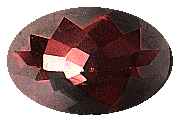Proteus Value, Price, and Jewelry Information
A few almandine/pyrope garnets from the US will change with treatment into proteus garnets. In reflected light, they have a dark gray, metallic luster. In transmitted light, the dark red of the garnet shows through.
Start an IGS Membership today
for full access to our price guide (updated monthly).Proteus Value
In Greek mythology, Proteus was a sea god, capable of changing his shape. It has become a noun for one who easily changes their appearance or principles.
Proteus are the only treated garnets. All the others resist change, but a few almandine/pyropes from the US will change into Proteus. The treatment brings a thin layer of metals to the surface.
This causes it to have a dual appearance. In reflected light, they have a dark gray, metallic luster, much like hematite. In transmitted light, the dark red of the garnet shows through.
International Gem Society
Related Articles
Garnet Buying Guide
Black Diamond Value, Price, and Jewelry Information
Chameleon Diamond Value, Price, and Jewelry Information
Gray Diamond Value, Price, and Jewelry Information
Latest Articles
Quartz Toxicity: Understanding the Risks for Jewelers and Wearers
Synthetic Amethyst: What is it and How is it Made?
Hambergite Value, Price, and Jewelry Information
Pearl Simulants: How to Spot Faux Pearls
Never Stop Learning
When you join the IGS community, you get trusted diamond & gemstone information when you need it.
Get Gemology Insights
Get started with the International Gem Society’s free guide to gemstone identification. Join our weekly newsletter & get a free copy of the Gem ID Checklist!
